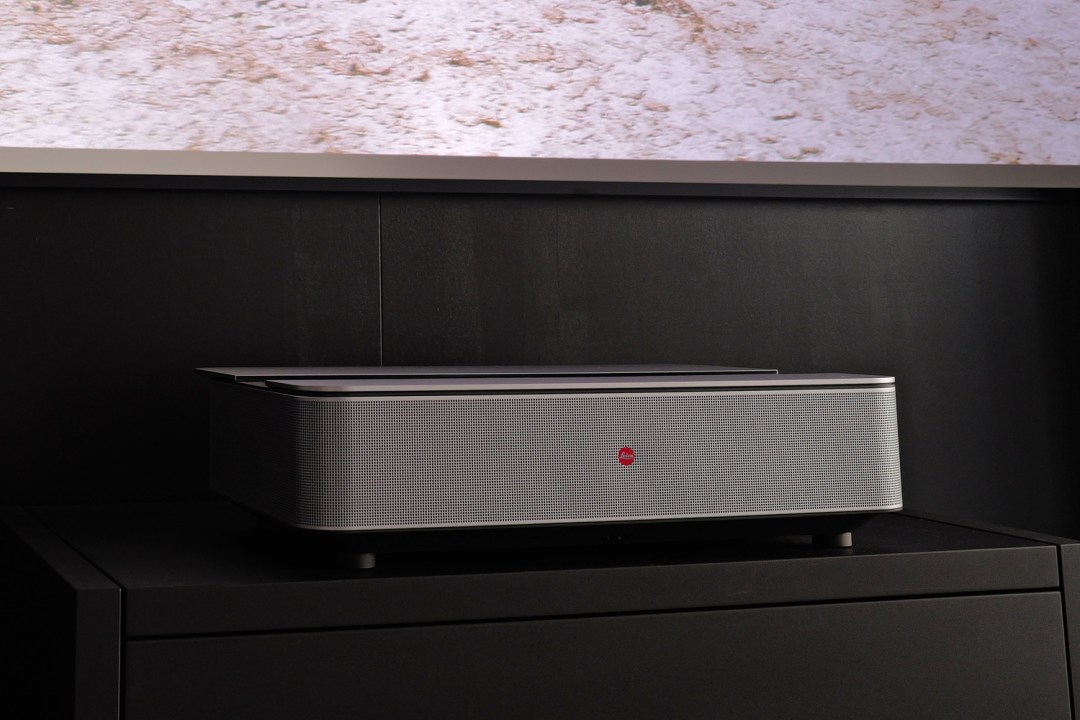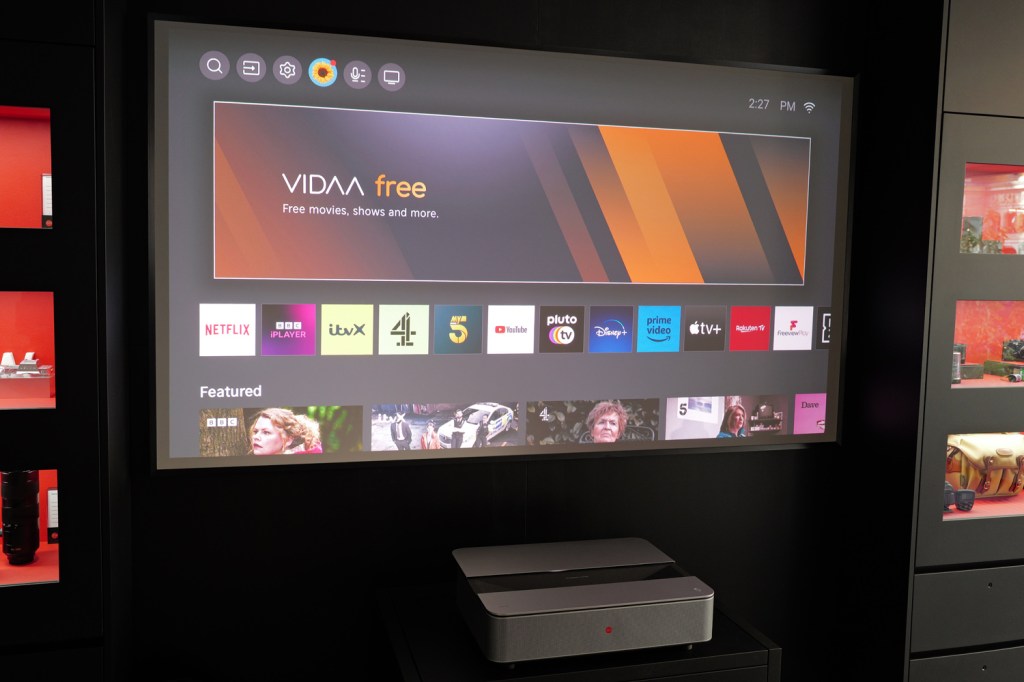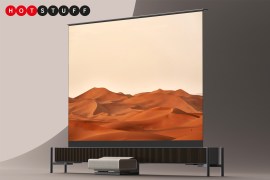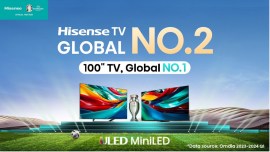Leica Cine-1 hands-on review: laser-guided luxury
Ultra-short throw projector wants to usurp your TV 24/7, not just for movie night

Stuff initial verdict
An unashamedly premium TV alternative that shines brightly, has all the right smart TV features, and properly looks the part.
Pros
- Bright enough for daytime telly
- Fully-featured smart TV and all the inputs you could need
- Gorgeous looks
Cons
- Hope you’ve got a large credit limit
- Need a screen to get the best picture
Introduction
The Cine-1 is what happens when you take Leica’s money-no-object approach to compact cameras and apply it to an ultra-short throw projector. This is no fairweather home theatre system that only comes out on movie nights – with an abundance of inputs, all the streaming services you could want and a laser bright enough for daytime viewing, it’s out to replace your existing TV with an 80in, 100in or 120in image.
It might be best known as a camera company, but this isn’t Leica’s first foray into film. The firm created some of the first 35mm slide projectors, and its lenses now make regular appearances on movie sets. That’s why, despite having been created with a little technical help from TV brand Hisense, the Cine-1 is packing a home-grown Summicron lens. It promises a super-sharp 4K picture, no matter how bright the room.
We took a trip to Leica’s London flagship store to see the Cine-1 in situ, to see if it could convince us to trade in our telly.
How we test projectors
Every projector reviewed on Stuff is put through its paces with a mix of film, TV and game content, using a combination of streaming services, Blu-ray and console games. We use our years of testing experience to judge picture and sound quality, ease of use, and value for money. Manufacturers have no visibility on reviews before they appear online, and we never accept payment to feature products.
Find out more about how we test and rate products.
Design & build: metal marvel



Ultra-short throw (UST) projectors are a great option for telly addicts who don’t want a giant screen dominating their viewing space 24/7. Just think how much room you’d need for a 100in or larger screen – and then how it’d make all your other furniture look dinky by comparison. Not so with the Cine-1: at roughly 60x38cm it has a slightly larger footprint than a Blu-ray player or set-top box. Dimensions are the same whether you go for the 100in or 120in version – it’s just the lens calibration that’s different, to support a bigger projection screen.
Part statement furniture and part tech showcase, it looks undeniably luxurious in silver aluminium. The perforated grille wrapped around the front and sides hides a pair of Dolby Atmos-approved, four-channel speakers, while a mechanical dust cover silently opens and closes as you power the projector on and off.
Leica logo aside, you could easily mistake it for a stealthy speaker or sound system until it’s switched on and the laser starts shining. While you’d want to hide competing UST projectors out of sight, this is one that can happily live on full display.
You could project straight onto a wall, but UST projectors work best with an ambient light rejection (ALR) screen – specifically ones with either Frensel or Lenticular treatments. These reflect and refract light differently to regular projector screens, which makes the picture look more vibrant and with higher contrast. Leica’s dealer network has teamed with third-party suppliers to offer them with Cine-1, as well as matching furniture.
For the ultimate stealth look, go for a cabinet with an integrated, motorised screen, which extends up as soon as you power on the projector. Just make sure you’ve got a sizeable credit limit first.
Features: taught by TVs



Around the back you’ll find three TV tuners – for aerial, cable and satellite broadcasts – that set the Cine-1 apart from rival UST projectors. There are also three HDMI inputs, a pair of USB ports for playing back local files, and a digital optical audio output. Ethernet is on hand if you prefer it to the on-board Wi-Fi. AirPlay and Android screen mirroring are bundled in, too.
That should all sound similar to a traditional TV, and the pattern continues when you dive into the menus. The Cine-1 has the same Vidaa smart TV UI as many Hisense TVs, and felt just as nippy as we’d expect for a 2023 set. It includes all the usual heavy hitters, including Netflix, Prime Video, Disney+ and Apple TV+, plus a whole host of catch-up services.
There’s also a full gamut of picture quality presets and settings to tweak, including a filmmaker mode. A gaming mode can drop input latency down to around 60ms, which should be ideal for twitch-reaction Call of Duty matches, although we didn’t get the chance to try it our during our demo session.
Unlike a TV, though, there’s some extra setup to be done here before you can kick back with a box set. Perfectly aligning the projector with your screen isn’t easy, and the manual keystone process can take a lot of button pressing. Leica’s Image Optimization (LIO) can use your smartphone to automatically calibrate the alignment, but we didn’t get ti see it in action. Instead we got a truncated version of the “white gloves installation service” Leica offers, which includes picture calibration if you want it.
We thought the aluminium remote control felt suitably premium, even if it perhaps has a few too many buttons, and it can operate over RF or Bluetooth – meaning you don’t need line of sight with the projector. Which is handy if you’ve recessed it into some furniture.
Picture and sound quality: beyond bright



The Cine-1’s three-laser, single DLP setup promises 4K resolution images at 60Hz, with support for a multitude of HDR formats. Technically the DLP chip has a native 1080p resolution, but it uses pixel shifting at 240Hz to deliver a ‘true’ UHD picture. To our eyes it looked wonderfully detailed; rapid eye movement revealed some rainbow effect colour, but we never found it distracting for regular watching.
At a whopping 3000 lumens, this is one seriously bright projector. Colours were vivid and contrast was impressive, without needing to be sat in total darkness. OK, the black levels aren’t going to rival a top-tier OLED, even with the best projector screen, but there was still an impressive amount of shadow detail on display during our demo – and that was with plenty of ambient sunshine seeping in from outside.
We were equally impressed by the built-in speakers, which delivered such impactful audio we could only crank it to 40% volume before we were risking noise complaints from the shops next door. It might not outshout a dedicated surround sound setup, but we reckon it has the oomph to fill even a sizeable room.
Leica Cine-1 initial verdict

Like Leica’s superb camera range, the Cine-1 isn’t aimed at the mainstream. It’s a luxury product that majors on style as well as the underlying tech, and that comes with a sizeable price premium. Expect to pay $8995/£8495 for the 100in version, or $9495/£8995 for the 120in model.
On the other hand, a 97in LG OLED will set you back a wallet-destroying $25,000/£25,000 – and will dominate the wall of whatever room you put it in. The Cine-1 is gloriously subtle in comparison. And yes, the similarly specced Hisense 100L9GTUK costs half the price of the Leica- but it isn’t nearly as nice to look at when powered off.
We’re sure there are plenty of affluent shoppers who’d prefer their home cinema to fade into the background of their minimalist penthouse, rather than reign over it. On first inspection, at least, it would seem the Cine-1 does exactly that.
Leica Cine-1 technical specifications
| Projection type | Single-chip DLP |
| Light source | Triple laser (25,000hrs claimed lifespan) |
| Resolution | 3840×2160 |
| Brightness | 3300 lumens |
| Connectivity | 2x HDMI 2.1, 1x HDMI 2.0, DVB-T, DVB-C, DVB-S tuners Ethernet, 2x USB, digital optical audio |
| HDR formats | HDR10+, HLG, Dolby Vision |
| Dimensions | 600x378x149 mm, 15.1kg |



